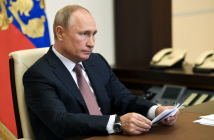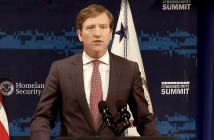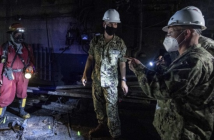Michele Evans, the executive vice president for Lockheed Martin Aeronautics, discusses the latest F-35 Lightning II fighter agreement with DoD, cutting unit and operating costs, the company’s role in Europe’s new combat aircraft programs, maintaining America’s advantage as allies and competitors increase stealth capabilities with Defense & Aerospace Report Editor Vago Muradian at the 2019 Paris Air Show where our coverage is sponsored by Bell and Leonardo DRS.
Vago Muradian: Welcome to the Defense and Aerospace Report. I’m Vago Muradian here at the Paris Air Show at Le Bourget, the historic airfield outside Paris where our coverage is sponsored by Bell and Leonardo DRS.
We’re here at the Lockheed Martin chalet to talk to Michele Evans who is the Chief of Lockheed Martin Aeronautics Sector, one of the world’s most formidable and storied airplane companies. Michele, thanks very much for the time.
Michele Evans: Thank you, Vago. I appreciate the time this morning.
Mr. Muradian: Certainly there is a lot going on, and it’s always great to be at an air show where there are a lot of new airplanes that are debuting. But I want to first start with the F-35. Obviously something that consumes a fair amount of your time, but you’ve got a great team. Greg Ulmer obviously the General Manager of the program. You guys are doing an enterprise-wide effort and working with your customer to try to get the cost down both on cost per flying hour as well as price.
What is the latest lot contract, the handshake deal you guys struck? Tell us about where you guys are going to go to that $70 million number and that much — I’m not going to use the number, I’ll let you use the number on cost per flying hour.
Ms. Evans: Again, Vago, as you reiterated, we did come to agreement on the next three lots of the F-35. The exciting part was years ago we committed to get to an $80 million jet, and that was by Lot 14 in 2020. This agreement actually gets below the $80 million jet by Lot 13. So a year sooner and we’re excited because I think it shows that we’re committed to the cost, and as you transitioned into sustainment we’ve developed the same kind of cost curve that we’re going to come down for sustainment. We’re committed to the 25,000 by 2025 and I think that we’ve been able to show that that commitment through the recurring price is now going to transition to sustainment.
So we’re excited to be here in Europe at the Paris Air Show. Certainly our European partners are a key part of the program and we have tremendous opportunities as we go forward with additional NATO countries looking at the F-35. So it’s been a great week for the team, and again, we’re excited about where the F-35 is and where it’s headed.
Mr. Muradian: You guys are also working advanced projects. Obviously the U.S. military is very interested in that, but so are our allies. Britain has developed the Tempest aircraft. We’re going to see where that falls in the market, but Italy is obviously interested in that product. We have the SCAF program that was formally launched here with France, Germany and Spain working together on something a little reminiscent of an F-22 front end with a YF-23 back end. Then we have the Turkish 5thgeneration airplane.
What does that tell us about where the market’s going to go? You guys have been the leader in stealth going back actually into the 1960s, frankly. But how do you see this market evolving? And the competitive landscape changing, where it once was an American dominated field and now there are more players in it, and certainly China with the J20 and obviously the Russians as well.
Ms. Evans: I think I’ll start with the performance of the F-35. As you talk to the pilots, they’re getting performance that far exceeds their expectation of the F-35, so the fact that the market’s following I think is a tribute to the F-35 performance.
The exciting part about F-35 is we’re already looking at modernization. And again, with the open architecture on the F-35 it’s going to allow us to really support that continuous development, continuous deployment of functionality. So the F-35 is going to continue to evolve and it’s going to keep pace with the threat. So we’re very focused on partnering with the U.S. government and other partner countries and continuing to upgrade the F-35.
So I view it as the market is following our lead, and the good news is the F-35’s out there, it’s performing, and it’s driving to a competitive price not only for acquisition but sustainment.
Mr. Muradian: So by partnership, do you see an opportunity to work closer even with potentially competing aircraft like the SCAF in order to be able to get the kind of degree of connectivity? We talked to General Philippe Lavigne, the Chief of the French Air Force, and he said look, a big focus is to make sure we’re all interoperable together with the F-35 and all the new platforms. Do you guys see Lockheed Martin playing a leading role in that?
Ms. Evans: I guess I’ll reiterate what Chief Goldfein has said. The F-35 is the quarterback of the battlefield, and I think what he’s referring to is, it’s really the quarterback of the entire network. So we talk about multi-domain operations and I think it’s perfect, the reflection of the F-35 and what it brings to the netted battlefield and the capabilities it brings.
So again, we do view it as a global partnership and that’s going to continue to grow.
Mr. Muradian: Tom Kennedy in talking to investors about the UTX-Raytheon deal that was announced that’s going to yield, pending government approval, Raytheon Technologies. So just as sort of the American supremacy or lead in stealth is basically evaporating. It’s going to be a great era of hypersonics. I’m getting that from an analyst friend who was in the meeting and sort of mentioned that to me yesterday. So I wasn’t there verbatim and I don’t know exactly what was said. But from your standpoint, is the American lead in stealth evaporating as the company that’s long prided itself on as the stealth leader?
Ms. Evans: So while we certainly see hypersonics coming, we believe stealth is going to continue to advance. So no, we don’t see stealth, that advantage being lost. Talk to a pilot, they will say given a choice they want the F-35 every single time, and that brings with it stealth. So we’re going to continue to develop and evolve the stealth capability. We understand hypersonics are coming. We’re going to play in that. Lockheed Martin across the corporation has multiple programs. We’ve been very successful with our hypersonics pursuits and we see the F-35 as an integral part of bringing all the capabilities together to that netted battle space.
Mr. Muradian: All customers are trying to balance the legacy aircraft with the next generation aircraft. If you look at it, F-16s are going to remain in inventory for a while. Elsewhere in the world you guys are actually stepping up your game on that to start competing for that lower end of the market. Still a highly sophisticated jet.
But I think some folks were surprised, for example, when the F-15X got a new lease on life, and folks are concerned that that’s actually going to take resources away, especially on the budget downturn from the F-35. Do you see that the same way, where investment in new old airplanes, as Dave Deptula likes to say, is something that’s going to undermine the foundation that you have on F-35? Where the size of the program, the numbers, are actually integral to reducing cost.
Ms. Evans: From Lockheed Martin, we see our F-16 business as helping many countries get on the path to F-35, so with F-35, with the recurring price with where we’re driving sustainment, the capability it brings and the fact that you can get a 5thgen fighter quicker than you can in most cases get a 4thgen fighter. We believe the F-35 is the choice. But again, we’re going to respect our customers’ choices and we’re going to support them as they see. We’re seeing increasing demands on the F-35 and we will support that. We’ve got the capacity to get up to 190 jets a year and we’re going to continue to support all of our customers to get that volume of F-35 into the fleet quicker and continue to drive the pricing down.
Mr. Muradian: It’s an interesting time. A merger and acquisition time, but also a time of partnership. We obviously have the L3-Harris deal ongoing; United Technologies-Raytheon has just been announced. But one advantage Boeing has always had is a very, very robust commercial business to offset and to support and give it all sorts of trade opportunities with some of its defense customers. That’s something that Lockheed has lacked since it got out of the commercial airplane business some years ago.
I remember being here two decades more ago and talking to Mickey Blackwell, one of your predecessors, about the importance of an alliance with Airbus at the time.
Talk to us about your partnership and alliance with Airbus, where it’s going, what the next steps are as you guys try to seek mutual advantage.
Ms. Evans: We signed an MOU with Airbus last December and we’re excited about the partnership. It has gone very, very well between Lockheed Martin and Airbus, and we really do see opportunities as you look at next gen refueling and tanking capability, mobility.
So we see opportunities. We bring a complementary capability. They’ll bring the base aircraft; we’ll bring the mission systems. And so we’re excited to continue to work with customers as they see opportunities to get that competitive cost per gallon of fuel to where they need it to refuel and have that tanking capability as well as expand it as we see the future of the mobility market as well.
Mr. Muradian: United Technologies-Raytheon. That’s an effort by obviously Raytheon but by both companies to try to get that counter-cyclicality that you get with a big commercial business and a big defense business. Again, an advantage that Boeing, for example, has enjoyed for quite some time.
Does this raise any competitive or other challenges? I know the deal is still fresh and you guys are looking at it, but are there any concerns about that deal? And conversely, does that mean that Lockheed, for example, may have to entertain that kind of a strategic transaction?
Ms. Evans: We’ll watch the deal go forward as will the entire market. My message to both companies has been you’re a key supplier on many of my platforms, and I need the continued focus on performance. As we manage the F-35 supply chain, it’s very critical that we have the performance. As we ramp to rate we need to know we’re going to get the quantity and the quality on time and excellent delivery performance. So my message is, continue to focus on performance while the deal works through.
From a Lockheed Martin perspective, we acquired Sikorsky a few years ago, so I think we’ve been very successful with the Sikorsky acquisition. It has put us in the commercial helicopter market, so we’re watching the market and we’ll continue to evaluate what makes sense for Lockheed Martin.
Mr. Muradian: Let me ask you a last question on future programs. Lockheed has always prided itself on being ahead of the power curve. I know that Skunk Works is not sitting by idly and doubtless has some of these products already in service, and I’m not going to push you on any of those. But how do you see managing the strategic shift to the future? The C-130 has been a great platform. There are competitors now on the ramp, whether in the form of the KC-390 or whether in the form of the C-2.
As you look at that space, how do you look to pave to the next generation? Sixth generation aircraft now is the buzzword within the Pentagon. Each of the military services is looking for that new high-end capability that has that greater range, has that greater payload capability. How do you balance that? How do you build a portfolio and a business plan that looks at at what point do you have to come out with a replacement, for example, for the C-130 even though it’s very successful, to sort of better prepare yourself for the future? Just like F-35 is great, but it’s actually now almost a 20-year-old airplane in terms of gestation and you want to move to the next generation.
Ms. Evans: Lockheed Martin is honored that we have a long history with Skunk Works. If you look back to the days of the SR-71, the U-2 and the F-117, and we aren’t going to stop.
I would kind of describe it in two ways. We’re very tightly listening to the customer where they see the threat going, how do we help them address that? And that’s not only in terms of technology that we would deploy but also as we think about modern tools. So as we think about digital transformation, start with model-based systems engineering, factories of the future, engineering for sustainment. We’re not only looking at what we do in terms of capabilities we deliver, but how do we speed up? How do we get to market quicker with those capabilities, looking at our engineering tools, our manufacturing capabilities, as well as how we engineer for sustainment, leveraging data analytics, AI and all the technologies that can help get capabilities to the market quicker.
So Skunk Works is very active and alive. We’re excited about the things we’re working, and we look forward to bringing those to our customers in the future.
Mr. Muradian: You triggered one other question which is, as you look to this future, there are folks who say that look, the F-35 is the last program that we’re going to have like this which is going to be joint and coalition and is complicated as it is, to try to fulfill so many different needs with one jet. And we have to get, you know, Dr. Roper talked to us about this. Shorter life spans, more cycle time. How do we get there? Is it because of greater internal systems, commonality and open architecture is where you’re just going to — you’ll discard the airplane before it even gets to its D check, for example. Like what are the ways to think about that where we will build many, many more types more quickly, keep them in service — you know, the century series concept. What’s the right way to think about that?
Ms. Evans: The first thing I’d like to say is the F-35 is going to continue to upgrade. It has with an open architecture; we’ve talked about continuous upgrades. The [JPO] will talk about C2D2 as really that path to continue to deploy. I’ll give you an example.
On F-16 we deployed the auto ground collision avoidance system. We’ve been able to pull that six years left in the F-35, and the reason is it’s an open architecture, we’ve been able to demonstrate the technology, and deploy it quickly. We’re going to continue to upgrade the F-35. So we don’t see it as a legacy jet. I get it, that it was developed many years ago, but it does have a very flexible architecture and we’re going to keep upgrading it.
In terms of when I think about next gen and as Dr. Roper talks about century series, that is a focus of Lockheed Martin. Again, it’s being able to quickly spiral capabilities and continue to address and pace that threat.
Mr. Muradian: Michele Evans, who heads Lockheed Martin Aeronautics. Always a pleasure, and best of luck. I look forward to seeing you again soon, even as soon as the Royal International Air Tattoo.
Ms. Evans: I look forward to it. Thanks, Vago.
Mr. Muradian: Thank you.
30



